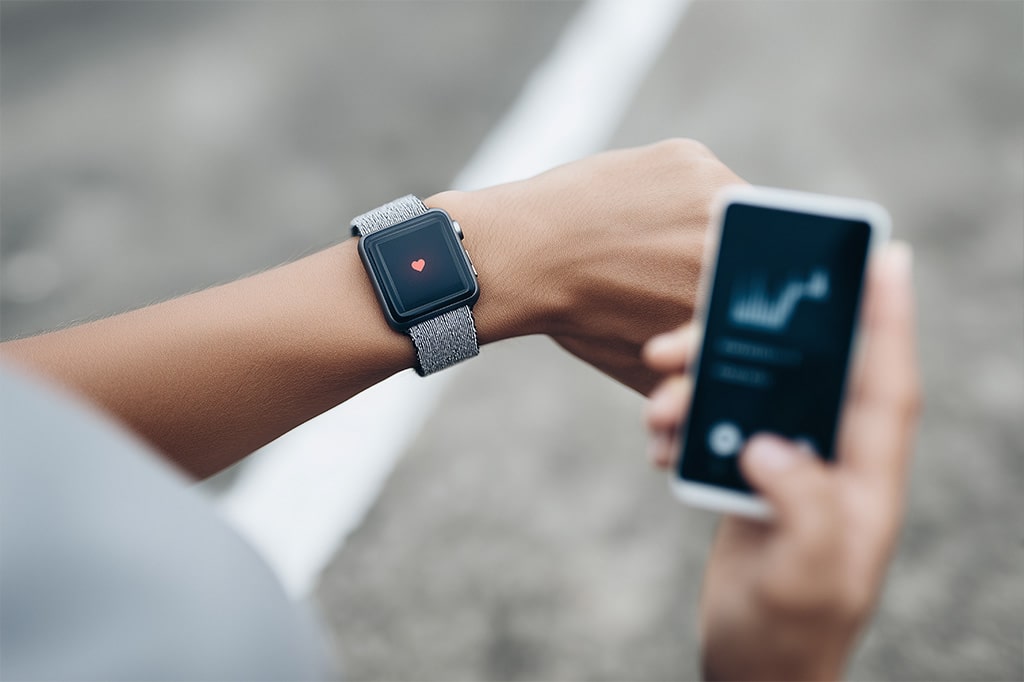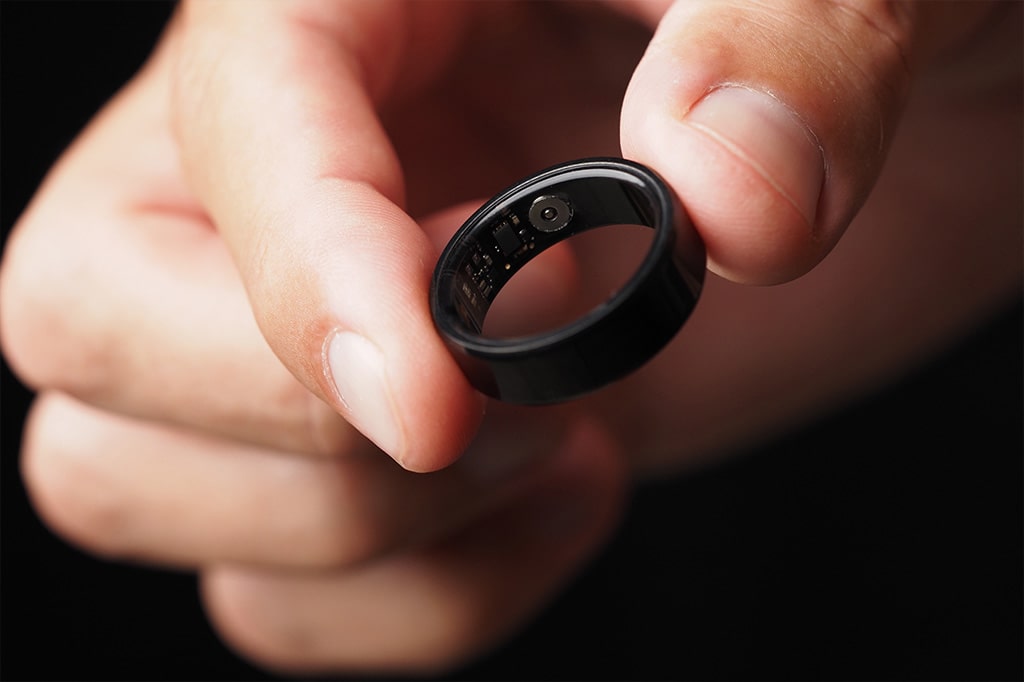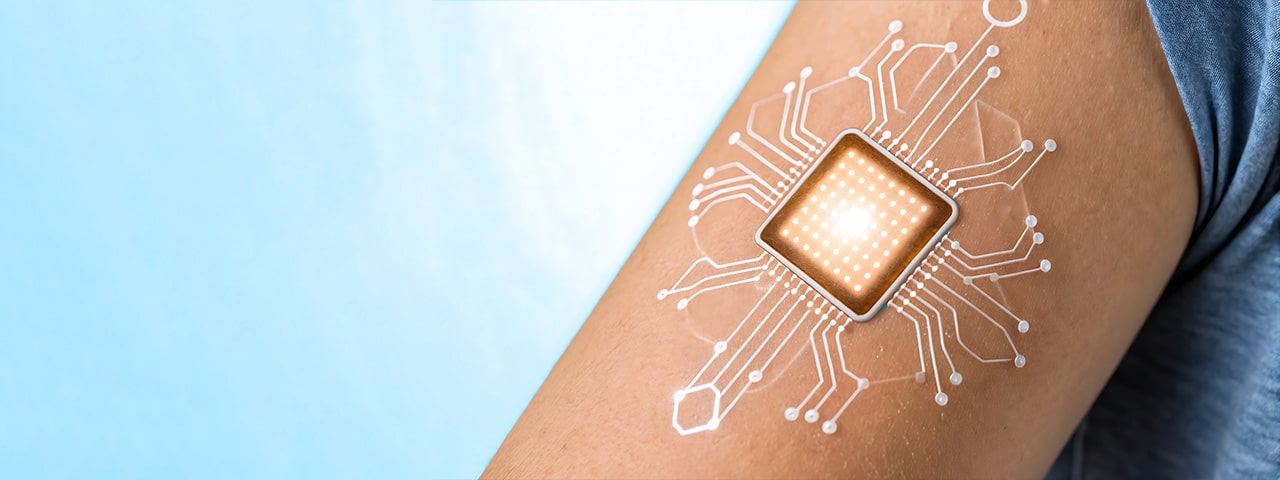Since around 2010, a new class of devices has been gaining attention on a larger scale: so-called wearables are small electronic devices that can measure physical, physiological, and environmental data using integrated sensors. In high-income countries, the proportion of users is already around 20 to 25 percent, and the trend continues to rise. Wearables are multifaceted and innovative electronics; in addition to the widely used fitness trackers and smart watches, smart clothing (e-textiles) and medical wearables are also available. Gadgets like data glasses, rings, necklaces, gloves, and shoes have also entered the market.
These are used in a wide variety of applications: From health monitoring (e.g. heart rate, ECG, sleep monitoring) to sports and fitness (step counters, calorie consumption, blood oxygen saturation, etc.) to specialised applications in industry (exoskeletons, stress measurement), medicine (sensor patches, smart inhalers, etc.), and the military (vital sign tracking for soldiers).
What technology powers wearables?
Every wearable device contains various sensors for motion detection. Accelerometers detect movements in the three spatial axes; gyroscopes measure rotational movements; GPS, GNSS, and barometric altimeters collect data on position in (three-dimensional) space. These physical sensors also include temperature and UV sensors, which contribute additional environmental data.
Special sensor technologies are required to measure physiological data such as heart rate, calorie consumption or certain brain activities. So-called PPG (photoplethysmography) sensors work with LEDs on the wearable device, which send light through the skin and can determine the pulse based on the reflection. A pulse oximeter works in a similar way: the wavelength of the reflected light can be used to determine the oxygen saturation in the blood. Portable bioimpedance sensors that provide information about body composition (fat, water, muscles, etc.) are still in development. Due to the reliance on radio-frequency signals, the energy requirements of such sensors are higher, which poses challenges for integration into a wearable device.
Wearables are often used in conjunction with smartphones (referred to as a companion) but can also be operated independently. In either case, specialised connection technologies are required to enable data transmission to other systems. Bluetooth Low Energy (BLE) plays a unique role here, as it has proven to be an energy-saving and cost-efficient technology for distances of up to about ten metres. However, WLAN, NFC and Zigbee are also used for networking wearables.

What are the challenges involved
in manufacturing and usage

Wearables are driving the miniaturisation of sensors and circuits, or indeed, made this possible in the first place. Much of this in terms of a few millimetres; there are already rings that promise to provide a comprehensive picture of the wearer's health, which requires corresponding expertise in both manufacturing and testing. Flexible conductor tracks are often used, for example in smart clothing, which require specialised test expertise. Extremely small grids and flexible, elastic substrates require innovative and advanced testing technologies. Testing radio-frequency signal transmissions and functional tests under real conditions on the body (movement, heat, unwanted electrochemical effects, etc.) can also be challenging. In view of the increasing demand for large quantities and the simultaneous requirement to reduce manufacturing costs, partially or fully automated production methods are becoming increasingly necessary. As a Partner for Future Technology, INGUN is constantly working to further develop test equipment and technologies to enable automated, contactless, and hybrid testing for wearables.
One challenge in operation is the power supply for wearables. In order to be able to continuously collect real-time data, long battery life and low energy consumption are required, yet space available for integrating a battery is extremely limited. Methods of so-called energy harvesting can help here: nanogenerators built into wearables generate electricity from the environment or from proximity to the human body. The relevant technologies are still under development and range from micro-photovoltaics and biofuel cells (e.g. energy generation from sweat) to energy generation from movement (piezoelectric) and touch (triboelectric); the use of air humidity (hydroelectric effect) is also being researched.
Data security is also a critical issue. Wearables collect sensitive physiological data that should not fall into the wrong hands or become public knowledge. As warned by the Federal Office for Information Security (BSI), among others, identity or data theft can lead to financial losses and damage to reputation. In the medical field, there is also the risk of manipulation of the data displayed on the wearable – with the consequence of serious health risks, for example in the case of self-medication. The BSI therefore advises users to ensure that wearables have secure hardware and software and to be aware of security risks when using them (e.g. when connecting to other devices).
Wearables and AI – a ‘natural’ symbiosis?
The convergence of wearables and artificial intelligence is obvious and already in full swing. Many manufacturers are integrating algorithms into their devices, essentially turning fitness trackers into personal coaches and smartwatches into life coaches. As increasing amounts of sensor data is collated and analysed holistically by AI, increasingly specific recommendations for action are tailored to the individual user; soon AI will know them better than they know themselves. One hope, for example, is that AI will make wearables more appealing for women, by better understanding and catering to their physiological differences and needs.
However, the aspects of data security and validity of wearables described above are becoming increasingly important: what if the AI ‘lies’ or ‘makes a mistake’? The more AI knows about the user, the more threatening data theft becomes. Additionally, the more the user relies on “their” AI, the more serious the consulting and health risks become in the event of manipulation or technical failure. Although the potential synergies of wearables and AI are so compelling that the trend towards convergence will be almost impossible to stop.
Will wearables soon be as normal as smartphones?
There are strong indications that wearables will continue to gain market share: the devices are evolving while becoming both increasingly affordable and functional. Battery life is increasing, and energy harvesting technologies are promising uninterrupted use. In addition, the benefits of artificial intelligence make wearables attractive even to people who are less tech-savvy. They are no longer mere gadgets, but instead well-meaning and highly informed companions. When used for health monitoring, it is comparable to always having a chief physician or professor with you.
Wearables will also continue to develop in terms of scope and increasingly cover specialised applications; not only for consumers, but also in industry, healthcare and other areas that are still completely untapped. However, as the scope of wearables increases, so does the risk of misuse. The faster the devices develop in terms of hardware, the more challenging it becomes to reliably test the built-in electronics. Using innovative contacting technologies such as SleeveProbe™, INGUN continues to demonstrate how specialised testing requirements can be efficiently mastered. As a Partner for Future Technology, INGUN is ready to support the dynamic evolution of wearables with its pioneering testing technology.
